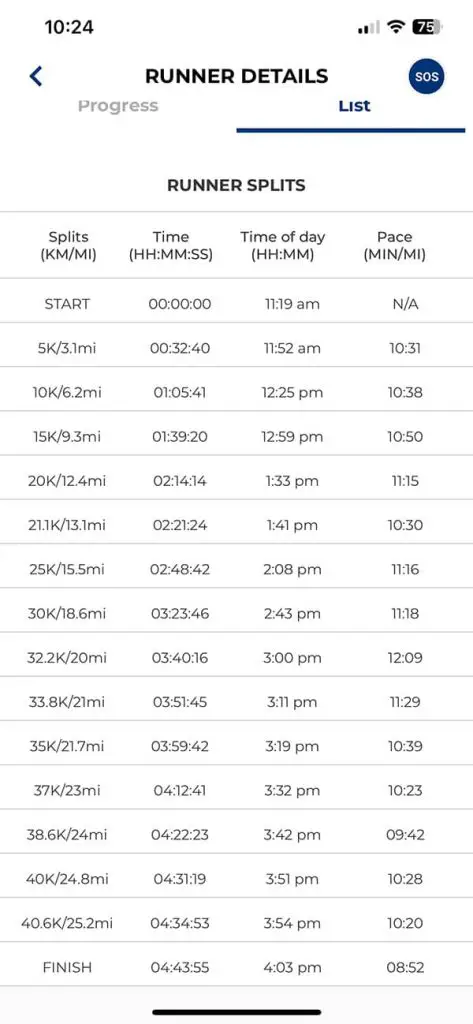Weekly Mileage For Marathon – Is That 20-Miler REALLY Needed?
‘Marathon training takes a lot of time’ – one might think. But it doesn’t have to… In fact, weekly mileage for marathon is a broad debate on social media. You’ll find tens of examples of people running a marathon without training or – vice versa – training extensively and consistently logging 100k (60mi) weeks. What’s the truth? And, more importantly, how many miles for marathon should YOU run in training?
In this post I’ll share a real life example of how a low mileage marathon training can be incorporated into a busy lifestyle and produce results. I’ll also share some tips on how to determine how many weekly miles for marathon training is appropriate in your specific life scenario. Let’s dive in!
Weekly mileage for marathon training
So, the big question – how many miles for marathon?
Looking purely at statistics, back in 2022 Strava released this summary of its users. It covers 80 million sessions over four years and provides a very good ballpark figure to begin with.

Based on these statistics, someone aiming to finish a marathon over 4 hours (for example, a recreational runner targeting his/her first marathon) can aim for 18-22 miles (29-35km) per week. A typical sub-4 marathoner averages around 35 miles (56km) per week. And more faster sub-3 runners clock around 50 weekly miles for marathon training (80km).
However, this is only part of the story. Remember, statistics take into account everyone – people training for their first marathon and seasoned runners preparing for their 10th one. The important factor to consider is the athlete’s background. Has he/she had extensive aerobic base training earlier? Is an athlete overall strong? Is there a history of recurring injuries? How durable he/she is? That is, how much pounding the body can take (or has taken over time).
Some people do need more weekly mileage for marathon than others to experience the same training effect. But it’s important to approach it carefully and focus on increasing the volume of easy training, not speedwork.
Read also: How To Run A 3-Hour Marathon On 30 Minutes Of Training/Day
Weekly mileage for marathon – easy training is key
Easy running is really at the core of becoming a stronger runner.
Aerobic training provides significant benefits to an athlete. It stimulates blood flow to the muscles, facilitates fat oxidation, develops mitochondria density, builds muscle strength, improves ligament durability and triggers other aerobic adaptations. Also called Zone 2 training, this type of training is done at 60% to 70% of your Heart Rate Reserve (HRR) or at a ‘conversational’ pace. That is, being able to carry on a conversation comfortably without experiencing significant pain or excessive breathlessness.
However, it’s important to note that training at an easy pace does not mean it’s inefficient or worthless.
Training at an aerobic effort yields more substantial (and lasting) gains compared to intense workouts. It also allows for gradual mileage increase and reduces the risk of overtraining & injury.
Is marathon training on low mileage possible?
Someone who is new to long distance running and doesn’t come from an extended training background will experience immense progress from building his/her ability to cover more distance in a single run.
But as I shared earlier – overall distance is not be-all end-all. Strength is another important factor to consider in long-distance running. We need to be overall resilient to withstand all the pounding the body takes during the marathon.
That’s how some athletes are able to run a half and even full marathon without training. To be precise, without specific training. Truth is, such athletes are in a pretty decent shape already and are able to use their strength to power through. In fact, a ~4-hour marathon is much more a strength & durability event, than it is a speed one. It’s more important to have strength in the muscles & joints to continue to move, than it is to move fast.

Marathon training on low mileage – Mark’s story
Some time ago I coached a person who is a busy executive at a multinational corporation. At 58 years old he was in a pretty good shape, but never ran more than 6 miles in his life. His routine consisted of a form of strength training every other day and walking the dog daily for ~3 miles (morning and evening). That is 21 miles per week on his feet just from walking the dog! I bet the dog has a good base for marathon training as well, lol.
Mark was kind enough to share his story. Here it is in full.
In early November of 2022, a friend at work asked me if I was interested in running the Boston Marathon. I have tried to stay fit by means of weight lifting or HIITs throughout my life…not always with success or consistency…and I was never a runner. Thus, I had no plans in my life to run in a marathon.
Life takes many twists and turns as you journey through it…and on Saturday, November 26th my 16 year old niece asked me to run in the 8k Austin Turkey Trot that next Thursday. It is much easier to turn down a marathon than my niece, so I accepted the invitation and started running/walking the next few days to try and desperately get ready.
Read also: First Time Marathoners – 18 Training, Taper & Race Day Tips
Boston-bound
In the meantime, the idea of running a marathon (let alone a hilly marathon), kept germinating in my mind that week and would not let go. I called my friend at work the Monday after committing to run with my niece and asked if the opportunity to run the marathon was still an option…she quickly reached out to a local, Hopkinton charity (The Michael Lisnow Respite Center) and got me signed up before I could realize what I was doing.
On Thanksgiving day, we ran for a mile, walked 60 seconds, ran for a mile and so forth to complete the Turkey Trot and had a great time…though my legs were quite wobbly afterwards! Thus, started the journey!
I read web sites, news articles, books and videos which quickly enabled me to piece together a half-baked plan to train over the next five months which included reaching a peak of 20 miles during my training…which was inconceivable at the time.

One of the key insights I gained in my research was utilizing heart rate training to build up my aerobic base, eventually run faster and help me run longer. After more research (yes, I was becoming obsessive), I quickly realized a running/fitness coach would be a great investment and increase my chances significantly of surviving the marathon as I had no idea how this journey would end.
I reviewed many sites and found a heart rate training resource page published by Andrejs which included not only great information on heart rate training but a coaching style that was data driven and focused on helping you through your journey. After speaking with Andrejs, we aligned quickly on a plan in early December that would help me reach my goal of running the Boston Marathon!

The Resilient Athlete
A Self-Coaching Guide to Next Level Performance in Sports & Life
Are you aiming to become a resilient athlete who is able to withstand any pressure? Be able to jump on any opportunity? Take any challenge life throws at you head on?
Then this book is for you.
Learn moreLow mileage marathon training – the process
Surprisingly, the time requirement for training was realistic and not excessive which was critical due to my work schedule. It was approximately 1-1.5 hours maximum each training day during the weekday with 1-3 hours on the weekend and 20 minutes of stretching on the rest days. Per Andrejs’ guidance, we utilized the app, Training Peaks, so he could input the trainings and also track my progress during our weekly video calls.
We built up the overall weekly miles for marathon training by approximately 10% each week to build the strength in my legs, joints and ligaments including an initial focus on aerobic capacity. That was followed by hills, speed drills and long runs on the weekend as I literally stepped, jumped or ran through the program with improvements every week.
Low mileage marathon training – setbacks and doubts
During the next five months, the only temporary challenges I had were self-inflicted with a bad golf swing in late January and a fall while playing pickleball for the first time while on spring break, which caused me to miss five days of training each time.
As I had tweaked my middle back during these two episodes, Andrejs worked with me to adjust the running plan to protect my back and capped my distance on the weekend to 13 miles on one day followed by 7-8 miles the next day. The concept was this total mileage was 95% the same as running it in one day…this is called putting trust in your coach and his expertise!
As we travelled to Boston and got ready for race day, the biggest question that always came up with myself or my wife in conversations with other people was: “What is the maximum mileage you have run in one day to get ready?” and “What’s your weekly mileage for marathon?”
Whenever, we mentioned 13 miles and the low mileage marathon training approach, it was either met with scepticism or raised eyebrows…
I kept saying to myself: “trust your coach”. We had a great training and race strategy including a nutrition plan for the race (energy gels, electrolytes, etc…) which we had reviewed beforehand…so the only thing left to do was run the race!
Read also: Flying To Run A Race? Beat Jet Lag With These Expert Travel Tips
Running the Boston marathon
I started the race in Hopkinton and kept to the race program which included starting at a zone 2 heart rate and slowly building it up at scheduled mile intervals.
The biggest challenge for me was twofold: 1) The mental aspect of running from mile 13 to 26.2 with only running up to 13 miles in my preparation and 2) The Boston marathon hills that are from mile 16 to 21 culminating with the infamous “Heartbreak Hill”.

As I passed mile 13 and entered the town of Wellesley I kept thinking to myself that Coach Andrejs was confident I could do it… And as I hit mile 16, I kept thinking “just make it one mile at a time” until mile 22 where it becomes primarily downhill to the finish line. Each mile passed and I continued to eat and drink my supplements with no problems. No nagging back aches, no muscle cramps and no tired muscles.
“I actually was passing people on the hills section and felt great as I hit the final stretch.”
The last four miles were faster than the rest of the race. I even slowed down to encourage another runner for about a half mile.
As I turned the final corner in Boston to reach Bolyston street, it was an incredible experience with the crowds and a huge smile was across my face as I finished the last 100 yards with my wife, nephew and his girlfriend in the stands cheering me on…as I raised my hand with a “hook em” horns sign for my wife and an ear to ear grin on my face as I crossed the finish line.

Post finish thoughts
My wife rushed from the stands to greet me while standing behind the guard rails. I swear, she was more excited and elated than I was to accomplish this challenge. This was an incredible journey that many family members and friends supported and tracked me while running.
It would not have been possible without their support and the guidance and mentorship of my running coach, Andrejs Birjukovs.
If you are wanting to pursue the goal of running a marathon, a triathlon or something similar, I would highly recommend speaking with Andrejs and making the investment to get the right support as you will increase your chances significantly along with your health and performance.

5 things to consider when answering the “how many miles for marathon” question for yourself
Mark’s story warms my heart and what he accomplished in span of 3-4 months makes me super proud. We had a lot of variables to work around. A busy schedule working as an executive at a large company. Not having the experience of running more than 6 miles before. Back injury during the pickleball game. And some in between.
But Mark was really consistent and that’s the #1 success factor in training. With a low mileage marathon training approach and focus on strength we built up his foundation and set him up for success. Not only in this race, but all further ones. If he so decides.
So, if you are thinking “how many miles for marathon should I run?” or “what should my weekly mileage for marathon be?”, consider these 5 areas.
#1 – Running background
Is this your first marathon? Or, perhaps, you have a few under your belt? Maybe even an ultra race? If so, the body remembers the training and will respond better to low mileage marathon training.
Marathon training does not need to be extensive. That is, running a 20-miler is not a necessity or a right of passage. Training can also be shorter and more frequent. Or intense. For example, famous Emil Zatopek’s interval training approach included him doing over 20 repeats of 400s on a track in a single session with minimum or no easy recovery days.
Reality is, marathon training should be tailored to what you can sustain over a longer time. Consistency is key, remember? And that holds true especially if you are a more seasoned runner who likely is overall stronger, resilient and has a better form.
Read also: Minimalist Ironman Training Program & Tips For Busy Triathletes
#2 – Injury history
If you have a history of injuries, especially inflammation related ones (i.e. various types of fasciitis), it’s another reason to avoid doing extra long days. Approach building total weekly mileage for marathon slowly and pay closer attention to the feedback the body provides. It’s a good idea to put more volume of cross-training in to build aerobic base (i.e. hours of cross-coutry skiing or cycling).
How we went around Mark’s back injury was to split his long days into back-to-back semi-long runs. A strategy used by many Ironman athletes to reduce run-related stress. Not necessarily a low mileage marathon training approach, but more of a way to still ‘load the legs’ without creating a disproportionally large training load in a single day.
#3 – Short & long term goals
What are your goals? Do you wish to enjoy the experience? Then don’t worry about the “how many miles for marathon” question. Keep your training consistent and aim for spending more time on your feet.
If you have heftier ambitions, like running a sub-3 in the future, then you need to be structured about it. See where you are with your easy run pace and weekly mileage now and compare to the average weekly mileage of a sub-3 marathon runner. If you’re close, then you can bump up a little more (if the body permits). If not, train where you are now.
More importantly, consider each race as a stepping stone, stay humble and build for the future. That is even if you don’t reach desired weekly mileage for marathon in the build-up for current race, continue building it for the next one.

#4 – Lifestyle
Are you an active person on a daily basis? Do you do strength training on a frequent basis? Are you a well-rounded person and practice multiple activities every week (i.e. running, swimming, pilates, yoga, etc.). If yes, chances are you already have a solid base for marathon training and would not need to include too much additional running into your lifestyle.
Personally, I found that people who consistently log 15k steps per day are structurally in a good shape to finish the marathon.
#5 – Stress & time availability
How does your day to day life looks like? Do you have plenty of free time throughout the day or is everything back-to-back-to-back? Putting an extensive marathon training on a 12-hour workday is a recipe for a burnout.
If your lifestyle is stressful, you won’t feel fresh for your runs, because stress delays recovery. In this case, a more frequent but shorter training would fit better. Play around with timing as well – sometimes a 45-minute lunch run fits better than an early morning session or evening one.
A good rule of thumb here is to consider additional 30-60 minutes after every run session as a wind-down time for ‘mental recovery’. For example, don’t schedule a meeting right after a run session, unless it’s a recovery one. Keep at least 30 minutes as a buffer to get to your appointment without rush.
Read also: 18 Practical Time Management Hacks For Athletes And Busy People
Weekly mileage for marathon – final thoughts and the “20-miler question”
So, do YOU need that 20-miler?
As you can guess, the answer is “it depends”… If you want to get better at marathon distance, you should, eventually, proceed to run longer, as it prepares you for the specific demands of a race.
According statistics, faster runners do log more weekly miles for marathon training. And that includes the marathon long run which is an effective all-around training tool. Running that long tests everything – your strength, endurance, nutrition, pacing, mental strength. And builds confidence towards completing the race.
However, a 20-miler is a workout that faster runners (i.e. sub 3:30 marathon) would benefit more from. For someone with an average easy pace of ~6:30min/km (10:30min/mi) it will take 3:30+ hours to complete the run. That’s quite a lot of time to spend on your feet, let alone running. Also, 20 miles would be a large share of weekly miles for marathon training, which can set a person up for an overuse injury.
So, would Mark run faster had he completed a 20-miler? Maybe, a little, but that would have created more fatigue and make him tired before the race. In the timeframe that we had and with his lifestyle (walking the dog daily and strength training), it was not possible. Had we had a longer timeline, we’d definitely built to a higher weekly mileage for marathon, but that is a story for another time.
Have an opinion? Share via links below and tag @theathleteblog
Tags In
Andrejs
GET A FREE TRAINING PLAN
Subscribe to my email list and get access to a free 4-week “back in shape” training plan
You’ll also get two full-body strength sessions and some other goodies!

How did I get here?
Hey there! My name is Andrejs and I am here to inspire, entertain and get you fit for any adventure.
I went from being an over trained pro athlete to an endurance coach sharing how to listen to your body and live life to the fullest.
Traveling, new sports & activities brought new meaning to my training and made it much more effective, fun and enjoyable. And I'm here to help you do the same.


